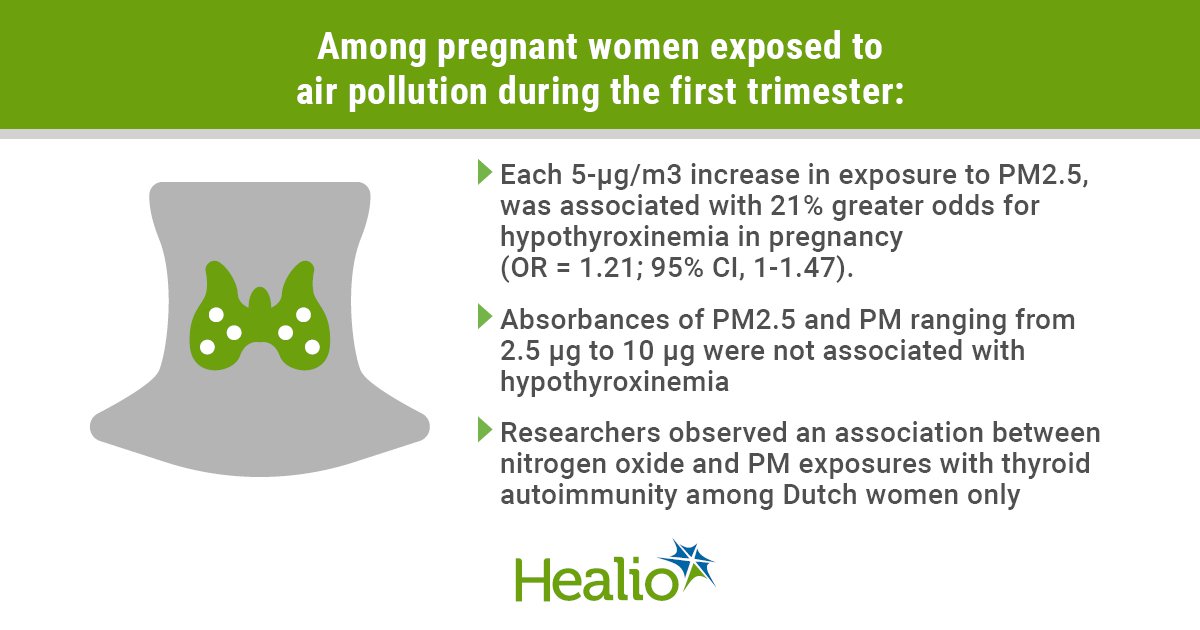Air pollution exposure increases thyroid dysfunction in pregnancy
Women exposed to air pollution during the first trimester of pregnancy are more likely to experience mild thyroid dysfunction throughout pregnancy, compared with unexposed women, according to findings published in JAMA Network Open.

“Particulate matter, which is made up of hundreds of different chemicals, was the air pollution component associated with mild thyroid dysfunction,” Akhgar Ghassabian, MD, PhD, assistant professor in the department of pediatrics, environmental medicine and population health at New York University School of Medicine, told Endocrine Today. “This finding suggests that mild thyroid hormone disruption in the mother might be one of the factors explaining the adverse effect of air pollution exposure on fetal development.”
Ghassabian and colleagues analyzed data on air pollution exposure and thyroid function from 9,931 pregnant women participating in four European cohorts and one U.S. cohort — the Amsterdam Born Children and their Development (ABCD) study, the Generation R study, Infancia y Medio Ambiente (INMA), Rhea, and Project Viva (mean age, 31 years; 56.6% nulliparous). Recruitment periods for the five studies ranged from 1999 to 2008. Researchers assessed residential air pollution concentrations, such as nitrogen oxide and particulate matter (PM), during the first trimester of pregnancy using land-use regression and satellite-derived aerosol optical depth models. Free thyroxine, thyroid-stimulating hormone and thyroid peroxidase (TPO) antibody levels were measured across gestation. Hypothyroxinemia was defined as a free T4 level below the fifth percentile of the cohort distribution, with normal TSH levels.
Exposure and risk
Across cohorts, 404 women (4.2%) had hypothyroxinemia and 506 (6.7%) tested positive for TPO antibodies. The researchers found that concentrations of nitrogen dioxide and PM with an aerodynamic diameter of 2.5 µm or less (PM2.5) were lower and had less variation among women in the U.S. cohort vs. women in the European cohorts.

For each 5-µg/m3 increase in exposure to PM2.5, researchers observed 21% greater odds for hypothyroxinemia in pregnancy (OR = 1.21; 95% CI, 1-1.47). Exposure to PM10 was not associated with hypothyroxinemia; however, the coefficient was similar to that for the association of PM2.5 with hypothyroxinemia, with an OR of 1.18 per 10-µg/m3 change in exposure (95% CI, 0.93-1.48).
Absorbances of PM2.5 and PM with aerodynamic diameter ranging from 2.5 µg to 10 µg were not associated with hypothyroxinemia. Researchers observed no associations between nitrogen oxide exposure and thyroid function.
In analyses stratified by study group, researchers observed an association between nitrogen oxide and PM exposures with thyroid autoimmunity among women participating in the Generation R study.
The researchers noted that the study relied only on measures of TSH, free T4 and TPO antibody status during pregnancy, using different assays among cohorts, and that there were no data available on secondhand tobacco smoke exposure among women.
Target ‘preconception period’
“We have known for long that thyroid hormone in pregnant women is essential for optimal development of the fetus,” Ghassabian said. “Global efforts to control iodine deficiency has advanced management of thyroid dysfunction in pregnant women and prevented harmful consequences for the health and development of offspring. Reducing exposure to environmental factors that disrupt thyroid function can be another effective preventive approach in vulnerable populations. Among environmental exposures, which disrupt thyroid function, air pollution is particularly important because exposure is widespread and malleable to change with correct policies.”
Ghassabian said emerging evidence points to the importance of a “preconception period” for both the mother and child’s health.
“A direction for future studies moving forward would be looking at exposure to air pollution over a longer period of time and prior to pregnancy to investigate the cumulative effect of exposure to air pollution on endocrine system and thyroid in women,” Ghassabian said. – by Regina Schaffer
For more information:
Akhgar Ghassabian, MD, PhD, can be reached at the Department of Pediatrics, Environmental Medicine and Population Health, NYU School of Medicine, 403 E. 34th St., Room 114, New York, NY 10016; email: akhgar.ghassabian@nyuumc.org.
Disclosures: The authors report no relevant financial disclosures.
